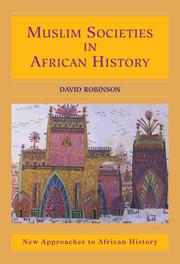Book contents
- Frontmatter
- Acknowledgments
- Contents
- LIST OF MAPS AND FIGURES
- INTRODUCTION
- PART I The Historical and Institutional Background
- PART II General Themes
- PART III Case Studies
- 7 Morocco: Muslims in a “Muslim Nation”
- 8 Ethiopia: Muslims in a “Christian Nation”
- 9 Asante and Kumasi: A Muslim Minority in a “Sea of Paganism”
- 10 Sokoto and Hausaland: Jihad within the Dar al-Islam
- 11 Buganda: Religious Competition for the Kingdom
- 12 The Sudan: The Mahdi and Khalifa amid Competing Imperialisms
- 13 Senegal: Bamba and the Murids under French Colonial Rule
- CONCLUSION
- GLOSSARY
- INDEX
9 - Asante and Kumasi: A Muslim Minority in a “Sea of Paganism”
Published online by Cambridge University Press: 05 June 2012
- Frontmatter
- Acknowledgments
- Contents
- LIST OF MAPS AND FIGURES
- INTRODUCTION
- PART I The Historical and Institutional Background
- PART II General Themes
- PART III Case Studies
- 7 Morocco: Muslims in a “Muslim Nation”
- 8 Ethiopia: Muslims in a “Christian Nation”
- 9 Asante and Kumasi: A Muslim Minority in a “Sea of Paganism”
- 10 Sokoto and Hausaland: Jihad within the Dar al-Islam
- 11 Buganda: Religious Competition for the Kingdom
- 12 The Sudan: The Mahdi and Khalifa amid Competing Imperialisms
- 13 Senegal: Bamba and the Murids under French Colonial Rule
- CONCLUSION
- GLOSSARY
- INDEX
Summary
I move now into case studies concentrated in shorter periods and spaces. The focus allows us to concentrate on particular persons and groups in their situations and to see the great variety of Muslim space, practice, and community across the continent. It is appropriate to begin with a “pagan” state and society, one that can in no way be called Muslim or Christian, and the situation of Muslim minorities within it. The state is the empire of Asante, singled out briefly in Chapter 4. In that chapter, I introduced the “Suwarian tradition” as a rationale developed by these Muslim communities for coping with their contexts; we may imagine similar traditions in other times and places as Islam emerged as a living faith.
The Emergence of the Asante Empire
Asante was not very old, but it came out of an old tradition. From about 1700 in the town of Kumasi, the Asante leaders built on a heritage of state formation, farming, artisan production, and long-distance trade that went back roughly 500 years. The Akan people, of whom the Asante were a part, began to create a record at the time the Empire of Mali was reaching its apogee, around 1300 c.e. Mali traders learned of gold mines in the southern forest. Encouraged by family firms and the state, they traveled south, established colonies around an Akan center called Begho, and began the export of gold to the savanna. Some of this gold reached North Africa and Europe, through the Transsaharan trade.
- Type
- Chapter
- Information
- Muslim Societies in African History , pp. 124 - 138Publisher: Cambridge University PressPrint publication year: 2004

